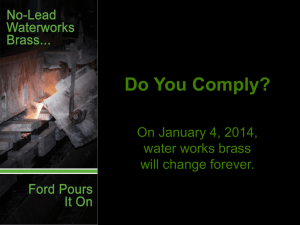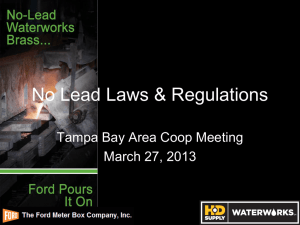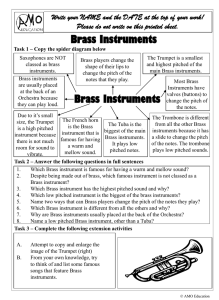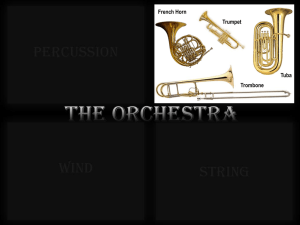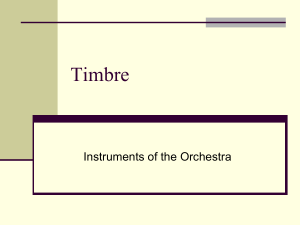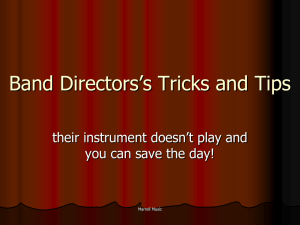No-Lead PowerPoint Presentation with Technical
advertisement
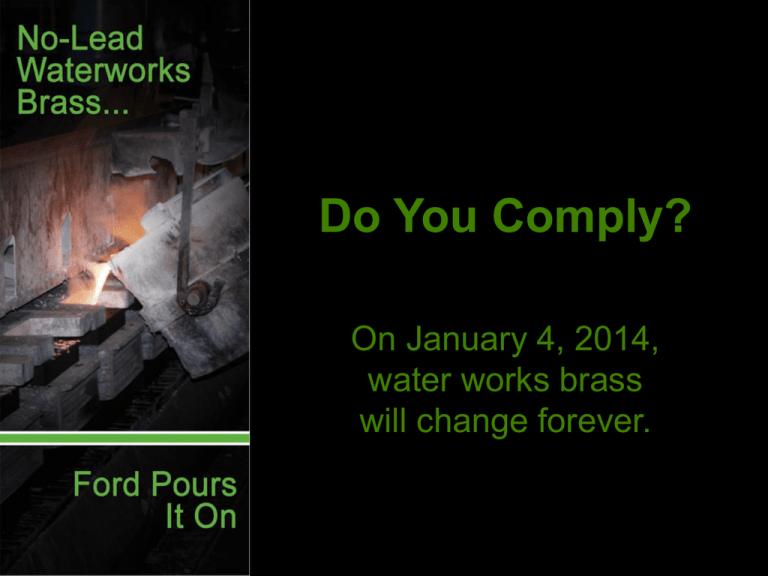
Do You Comply? On January 4, 2014, water works brass will change forever. Legislation • In January of 2011, the President signed into law Senate Bill 3874 and created the Reduction of Lead in Drinking Water Act. • This legislation amended the Safe Drinking Water Act to reduce the allowable lead content in all products in contact with drinking water from 8.0% to 0.25% (weighted average). When does the new law take effect? • • When does the new law take effect? •Nationally: This new law goes into effect on January 4, 2014 • •Some states have adopted laws with more aggressive timelines for no-lead brass – –California: Already requires no-lead brass – –Vermont: Already requires no-lead brass – –Maryland: No-lead brass required by 1/1/2012 – –Louisiana: No-lead brass required by 1/1/2013 Definitions No-Lead, Low Lead, Lead Free, Federalloy, EnviroBrass •Basically, these terms all mean the same thing… – We do anticipate future standards and specifications to clarify some of the industry jargon, as well as the variety of product labeling that exists today. 5 The new Federal Law carries the most weight for the Ford Meter Box Company by specifically defining the allowable lead content (0.25%) of our brass products in 2014. Are any products exempt? • The new law applies to the wetted surfaces of any product used in a potable (drinking) water system • Products used for nondrinking water applications (reclaimed, industrial, etc.) and brass service saddles are exempt from the nolead requirements How will this impact current standards? • • In response to the California no-lead law, NSF Standard 61 Annex G was created in 2008 to provide independent certification to the California law In 2010 NSF Standard 372 was created to permit all products to have independent certification to the new state laws. NSF 372 will supersede Annex G • NSF 61 is a voluntary standard currently specified in a number of markets • AWWA C800 currently references the Safe Drinking Water Act requirements and will be updated nearer to 2014 to remove leaded brass from the permitted wetted contact material list • NFS/ANSI Standard 372 is our primary focus moving forward for users not requiring NSF/ANSI Standard 61 No-Lead Brass Specifications • • Made from UNS/CDA No C89833 cast alloy UL Classified to NSF/ANSI Standard 61 and Standard 372 • Brass components in contact with potable water shall be of No-Lead Alloy (UNS/CDA No C89833) • UNS/CDA No C89833 conforms to AWWA C800 and ASTM B-584 • Components that do not come in contact with potable water shall be UNS/CDA No C83600 - 85-5-5-5 and shall conform to AWWA Standard C800 (ASTM B-62 and ASTM B-584) • Ford No-Lead products are identified by “NL” on the major body component No-Lead Brass Specifications Good News Ford Meter Box is Ready! • Ford provides (and stocks) a complete no-lead line of brass waterworks products that meet the new legislation • Add the “-NL” suffix to your current part numbers No-Lead Brass Identification • Ford No-Lead products are identified by “NL” on the major body component • •Ford No-Lead products are packaged with a lime-green box label, and have “NL” at the end of product number What does this mean for me? • All current waterworks brass inventory becomes obsolete and can not be sold (or used) after January 4th, 2014 (unless your state adopts an earlier deadline) • Begin planning now to cycle out your current brass inventory and replace with the new no-lead brass products • Contact your local Ford Meter Box representative to develop a transition plan Handling and Installing No-lead Brass The Basics No-lead alloys, at a minimum, require the same care as traditional waterworks brass. For best results, besides specific product instructions provided, follow these general instructions. 1. Handle carefully…protect threads...keep clean…do not drop or throw. Do not use a pipe wrench. 2. Always use a suitable sealant or Teflon tape on tapered threads. 3. Use only smooth-jawed, adjustable wrenches that fully and evenly engage the wrench flats. Loose fitting wrenches and pipe wrenches will distort the valves or fittings and cause leaks. 4. Place wrenches only on wrench flats provided, not on round surfaces. Handling and Installing No-lead Brass The Basics 5. Use extra care not to over tighten connections, which could distort or break the brass. 6. Use extra care not to exert side / down forces on the brass to avoid distorting or breaking the valves and fittings. 7. Always inspect and pressure test before backfilling. 8. Backfill and compact carefully to ensure the brass and service line are properly supported and not stressed by the weight of the earth. 9. Protect from freezing. Frozen water can expand and damage brass, causing leaks.
